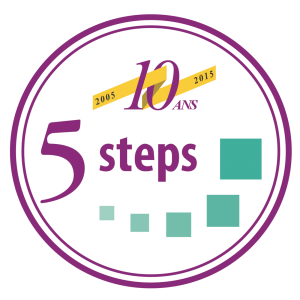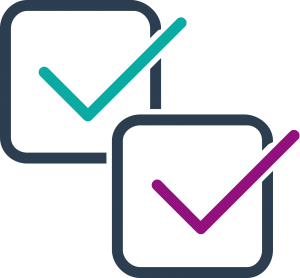

5 Steps is a framework that has been designed to solve major challenges that organizations face while implementing a strategy. This specific method :
Co-developed in 2004 by MNM Consulting and Valeo Group, the 5 Steps framework has already been implemented :

For each major strategic goal, the framework determines 5 levels of progress (“5 Steps”). Each level corresponds to the organizations’ significant progress towards this goal.
Unlike other methods, these 5 levels are not generic: they are defined by the organization for each topic. As a result, the framework is adapted to your organization’s maturity level and to what it is capable of achieving, not what it would wish to do.
This breakdown into 5 levels sets a pace for progress in successive and achievable stages and can be replicated throughout the whole organization: it allows each employee to follow progress towards a strategic objective step by step.
These 5 levels are used for the construction of (roadmaps) which are at the heart of the framework and which we will detail hereafter.
The 5 Steps roadmap is a tool used to define a rational and harmonious path to the achievement of strategic goals. The topic of a roadmap corresponds to one of the major areas of achievement of a strategic action plan. It is often linked to a specific functional network.

The roadmap itself is a matrix that is defined by two dimensions :
Each “step” that is cleared for a given group corresponds to a requirement. It is fulfilled using deliverables that act as factual proof.
The standardized format of a roadmap is common to all topics and contributes to a better understanding of strategic goals at all levels of the organization. Consequently, employees can adopt these goals as their own and the management can control the implementation of the strategy.

The number of roadmaps depends on the strategic action plan chosen by the company. Typically there are at least as many roadmaps as there are major strategic areas included in the strategic action plan.
Following the drafting of roadmap templates, they are assigned and deployed simultaneously or successively to all or part of the organization’s operational entities.
Through a system of feedback, roadmap users have the opportunity to suggest improvements directly to the roadmap editors. These suggestions, often based on good practices, contribute to the development of roadmaps and to the sharing of know-how.

Besides their role of accompanying the organization gradually towards the achievement of strategic goals, roadmaps also serve a tool for measuring this progression. Once deployed, the roadmaps enable operational entities as well as the general management to assess and compare their progress towards the strategic plan’s goals.
Several indicators can be established. For example, the number of entities to which roadmaps have been assigned illustrates the organization’s responsiveness regarding the launch of a strategic action plan. The entry speed of deliverables indicates the starting pace of a roadmap. In addition to these indicators, entities may self-assess each roadmap through “coverage” and “level” ratings.
Coverage rating refers to the percentage advancement of the roadmap compared to the maximum target (total number of requirements fulfilled compared to the total number of requirements listed in the roadmap).
Level rating refers to the positioning of a roadmap in relation to the 5 levels of requirement. The entity’s rating goes from 1 to 5. In addition, one can use a decimal to assess the progress of the current level of requirements.
All of these indicators and ratings – possibly linked to usual KPIs – can be consolidated and consequently enable general management to manage the implementation of the strategic plan and promptly make any adjustments if necessary.

![]() Strategic goals are well understood and the expected contribution is clear.
Strategic goals are well understood and the expected contribution is clear.
The 5 steps roadmaps’ structure facilitates a description of the strategy in simple and understandable actions that can be adapted at every levels in the organization.
![]() Daily actions are linked to overall strategic goals.
Daily actions are linked to overall strategic goals.
The requirements needed to achieve these goals are described, organized and sequenced in the 5 steps roadmaps. Daily actions contribute to the completeness of the roadmaps’ requirements and, consequently, to the realization of the strategy.
![]() Support functions and management lines cooperate in the drafting of 5 steps roadmaps.
Support functions and management lines cooperate in the drafting of 5 steps roadmaps.
Each point of view is therefore taken into account during drafting. This allows a holistic view of roadmap topics while ensuring that goals are more easily adopted by operational teams.
![]() Progress is visible within the organization.
Progress is visible within the organization.
The advancement level of a roadmap, which is notably determined by the input of factual evidences, allows everyone to view their own contribution and progress towards the achievement of goals.
![]() The best practices are put forward.
The best practices are put forward.
Through 5 steps’s feedback system, everyone has the opportunity to support the construction of future strategies by communicating the best practices to perform the requirements/tasks they are responsible for.
La société 5 steps, composée de consultants et d'une équipe R&D, développe la méthode, anime un réseau de partenaires experts, assure la formation et l'accompagnement de ses clients sur des missions de mise en oeuvre.